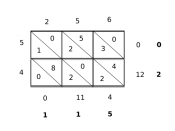Lesson Plan: 4HP Tuesday, 12 March 2002 Subject Focus: Maths - Pencil and paper procedures (Division).
Duration: 55 minutes.
Number of Children in Class: 29 Groupings: Lower group sitting near each other and will be overseen by Class Room Assistant.
Higher groups working from the same starting point.
I.E.Ps: 6 stage 1, 1 Stage 2 and 3 Stage 3.
Resources: Worksheets: Dividing using pictures and multiplication prompts (2 sides) - lower group.
Division 2 sides of scaffolded recording of division method - starting point for higher groups.
ECM15 - further examples.
Vocabulary Poster.
Clock face for mental practice, on reverse multiples of 9.
Array cards and packaging illustrating arrays.
Vocabulary Division Divide by Divide into Group Share Separate Remainder Inverse Approximate Approximation Lesson Objectives ÷ Mental: Sharpen 9 times table.
÷ Develop and refine written method for TU / U working towards finding a remainder.
Assumed knowledge and skills ÷ Assume knowledge of 2, 3, 4, 5 and 10 times table.
Mental Work (5 minutes) ÷ Class recite 9X table using clock face as a prompt ÷ Play Gladiators using multiples of 9 on poster / or save for post-plenary.
Learning Activities (20 minutes teacher input / 20 minutes pupils consolidation) We are going to be looking at division today.
What does division mean? (Vocabulary and explanations) Show children arrays and ask for corresponding division sentences Lower group's work will link to this.
How many tins of at food will fit into this tray? If my cats ate 2 a day - how many days supply are there? If my cats ate 3 a day - how many days supply are there? I have 15 eggs.
If 3 people share them out equally how many eggs does each person have? Could 5 people share the eggs out equally? How many would each have? Could 4 people share the 15 eggs equally? How many would each person have? How many are left over? What do we call this? Today: We are going to divide more 2-digit numbers by 2,3,4 or 5.
36 ø 3 Can anyone tell me what the answer will be close to? Explain please? It is a good idea to see if you can make 10 groups of 3. This will help you approximate.
88 ø 4 What will be the approximate answer (20) or 96 ø 3 What will be the approximate answer (30 When we calculate we must check that our answer is close to our approximate answer.
We can record how we work out the answer like this 88 ø 4 = 88 -80 20 X 4 8 -8 2 X 4 0 20 + 2 = 22 Sometimes there will not be so many groups. So instead of finding groups of 10 you may find smaller groups.
If I wanted to share 24 apples between my family of 4 how would I write this down? 24 ø 4 = How many groups of 4 could I try? Similar example on the board.
Explain to the children it is important to find "break down the sum" using multiplication facts that they already know. The parts can then be added together.
Pupil work Lower group - shall write division sum for sharing pictures then find simple divisions by using multiplication prompts.
Upper groups - shall follow the written division method on 2 sides of a sheet.
Extension work - children write approximate answer and use written method to work out the answer for each question (ECM15) in their exercise books.
You will have 15 minutes to practice division calculations.
Plenary (10 - 15 minutes).
Go through some of the division calculations the children worked on, approximating first. Invite the children to explain their work.
What have we learnt today? Dividing 2-digit numbers by 2, 3, 4 or 5.
Approximate first.
Breakdown sum into simpler parts.
Division is repeated subtraction of groups.
Key questions.
Why is it important to approximate first? Do you think this method has helped you divide accurately? Why? Have we all broken down the division calculation in the same way? Does it matter how the calculation is broken down? Do you believe that we have achieved today's objectives?


